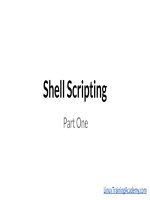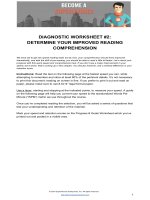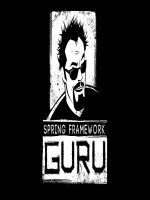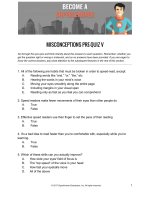063 structures kho tài liệu training
Bạn đang xem bản rút gọn của tài liệu. Xem và tải ngay bản đầy đủ của tài liệu tại đây (200.04 KB, 21 trang )
BASIC ASSEMBLY
Assembly language programming
By xorpd
Memory
Structures
xorpd.net
OBJECTIVES
We will study structures.
We will learn how to organize our data and our programs
using structures.
We will understand the idea of unions, and how to use them.
GIVING MEANING TO YOUR DATA
The processor cares about bytes.
You care about the meaning of your data.
Example: How to store a point in memory?
A two dimensional point has two coordinates.
We could use two consecutive DWORDs.
401000
401001
401002
401003
401004
401005
401006
401007
04
00
00
00
03
00
00
00
X
Y
POINTS DECLARATION
Declaring one point (First round):
section '.bss' readable writeable
; Declare a point:
pnt
dd
?
dd
?
section '.text' code readable executable
start:
mov
mov
dword [pnt],4
dword [pnt + 4],3
This code is a bit hard to understand.
POINTS DECLARATION (CONT.)
Declaring one point (Second round):
section '.bss' readable writeable
; Declare a point:
px
dd
?
py
dd
?
section '.text' code readable executable
start:
mov
mov
dword [px],4
dword [py],3
A bit easier to read.
POINTS DECLARATION (CONT.)
Declaring a line (two points):
section '.bss' readable writeable
; Declare a line:
; First point:
p1x
dd
?
p1y
dd
?
; Second point:
p2x
dd
p2y
dd
?
?
section '.text' code readable executable
start:
mov
dword [p1x],4
mov
dword [p1y],3
mov
mov
Not so fun :(
dword [p2x],5
dword [p2y],1
POINTS DECLARATION (CONT.)
; Declare a line:
; First point:
p1x
dd
p1y
dd
; Second point:
p2x
dd
p2y
dd
The problems with the line example:
?
?
?
?
...
We have to write 4 lines of code to declare one line structure!
It is hard for the reader to understand the bigger line concept:
He only sees two points, or 4 dwords.
We might later want to create a triangle, for example.
We might want to reuse the point concept, but we have to write the same
lines of code over and over again.
What if we wanted to change our point to be 3 dimensional?
We will have to change every line definition.
STRUCT
The assembler can help us define our data structures.
The struct assembly directive allows to define data structures:
struct PNT
x dd ?
y dd ?
ends
section '.bss' readable writeable
; Declare a point:
my_pnt
PNT
?
section '.text' code readable executable
start:
mov
dword [my_pnt.x],4
mov
dword [my_pnt.y],3
STRUCT (CONT.)
Struct is just a directive, not an instruction.
Your structs will not show up in the final binary.
They just help you to write your code.
The assembler does the dirty work for you.
struct PNT
x dd ?
y dd ?
ends
section '.bss' readable writeable
; Declare a point:
my_pnt
PNT
?
section '.text' code readable executable
start:
mov
dword [my_pnt.x],4
mov
dword [my_pnt.y],3
section '.bss' readable writeable
; Declare a point:
pnt
dd
?
dd
?
section '.text' code readable executable
start:
mov
dword [pnt],4
mov
dword [pnt + 4],3
DEFINING STRUCTURES
Defining structures.
struct PNT
x dd ?
y dd ?
ends
Begins with the struct directive.
Ends with the ends directive.
Everything in the middle is considered to be data inside the structure.
Structs are usually defined before any section definitions.
But could be defined anywhere in your source file.
The definition creates a set of labels:
PNT.x
PNT.y
sizeof.PNT
= 0
= 4
= 8
You may pick default values for the fields of the struct:
struct PNT
x dd 3
y dd 5
ends
STRUCTURES DECLARATIONS
Given a structure definition, we can declare data:
section '.data' data readable writeable
; Declare point with initial values:
my_pnt1
PNT
3,4
section '.bss' readable writeable
; Declare point:
my_pnt2
PNT
?
The declaration creates a set of labels:
my_pnt2
my_pnt2.x
my_pnt2.y
struct PNT
x dd ?
y dd ?
ends
STRUCTURES DECLARATIONS
Given a structure definition, we can declare data:
section '.data' data readable writeable
; Declare point with initial values:
my_pnt1
PNT
3,4
section '.bss' readable writeable
; Declare point:
my_pnt2
PNT
?
The declaration creates a set of labels:
my_pnt2
my_pnt2.x
my_pnt2.y
= 0x402000
= 0x402000
= 0x402004
struct PNT
x dd ?
y dd ?
ends
USING STRUCTURES
Accessing one field:
struct PNT
x dd ?
y dd ?
ends
section '.data' data readable writeable
; Declare a point:
my_pnt
PNT
3,4
section '.text' code readable executable
start:
mov
eax,dword [my_pnt.y]
call
print_eax
The result is 4.
mov
call
eax,dword [my_pnt + PNT.y]
print_eax
mov
call
eax,dword [my_pnt + 4]
print_eax
USING STRUCTURES (CONT.)
Getting the size of the structure.
struct PNT3
x dd ?
y dd ?
z dd ?
ends
section '.data' data readable writeable
; Declare a three dimensional point:
my_pnt
PNT3
5,6,7
end_pnt:
section '.text' code readable executable
start:
mov
eax,sizeof.PNT3
call
print_eax
mov
call
Here the size is 0xC.
eax,end_pnt – my_pnt
print_eax
NESTING STRUCTURES
You can define structures using other structures:
section '.data' data readable writeable
; Declare a colored line:
my_line
CLINE
0,<3,4>,<1,5>
struct PNT
x dd ?
y dd ?
ends
section '.text' code readable executable
start:
mov
eax,dword [my_line.color]
call
print_eax ; 0
struct CLINE
color
dd ?
p_start PNT ?
p_end
PNT ?
ends
mov
call
eax,dword [my_line.p_start.x]
print_eax ; 3
mov
call
eax,dword [my_line.p_end.y]
print_eax ; 5
CLINE
color
p_start
color
0
1
2
p_end
x
3
4
5
y
6
7
8
9
x
a
b
c
d
y
e
f
10
11
12
13
NESTING STRUCTURES (CONT.)
You may also nest anonymous structures (Without a name).
In this example:
DLINE.red
DLINE.green
DLINE.blue
DLINE.p_start
DLINE.p_end
sizeof.DLINE
struct DLINE
struct
red
db ?
green db ?
blue db ?
db ?
ends
p_start PNT ?
p_end
PNT ?
ends
=
=
=
=
=
=
0x0
0x1
0x2
0x4
0xC
0x14
; (Anonymous)
; (placeholder)
UNIONS
We sometimes want to think about the same chunk of data in two
(or more) dif ferent ways.
This is what unions are for.
Example: We want to store IP address (IPv4) as a dword, but also be
able to access each byte separately.
struct IPV4
union
struct
a db ?
b db ?
c db ?
d db ?
ends
addr dd ?
ends
IPV4.addr
IPV4.a
IPV4.b
01
IPV4.c
00
IPV4.d
00
7f
ends
Unions basically create more labels with the same values.
UNIONS (CONT.)
Defining unions:
Unions are defined inside structs definitions.
They are anonymous (Have no name).
The definition begins with the union directive, and ends with ends.
Inside unions, the of fset does not increase.
struct PNT
x dd ?
y dd ?
ends
Example:
PNT.x
PNT.y
=0
=4
PNT.x
PNTU.x
PNTU.y
=0
=0
PNTU.x
PNTU.y
struct PNTU
union
x dd ?
y dd ?
ends
ends
PNT.y
UNIONS IPV4 EXAMPLE
section '.data' data readable writeable
; localhost:
lhost
IPV4
<127,0,0,1>
section '.text' code readable executable
start:
mov
eax,dword [lhost.addr]
; eax == 0x0100007f
mov
eax,dword [lhost]
; eax == 0x0100007f
mov
bl, byte [lhost.d]
; bl == 1
mov
bl, byte [lhost + 3]
; bl == 1
struct IPV4
union
struct
a db ?
b db ?
c db ?
d db ?
ends
addr dd ?
ends
ends
SUMMARY
Structures help us to declare meaningful objects in memory.
In assembly language, Structures are just a smart way to
define labels.
They only help you to write your program.
Can not be seen in the resulting binary.
Unions allow us to deal with the same memory location in
more than one way.
EXERCISES
Read code.
Write code.
Have fun :)









